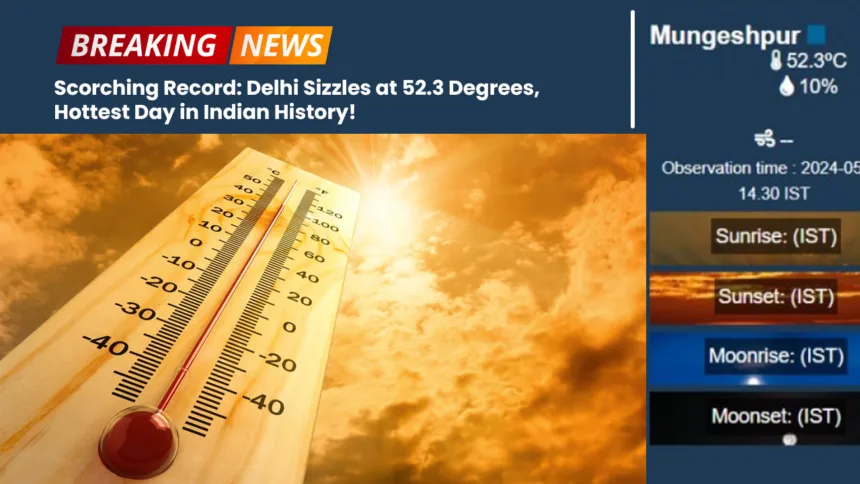In an unprecedented meteorological event, the temperature in Delhi soared to a record-breaking 52.3 degrees Celsius on Wednesday, marking the highest temperature ever recorded in the national capital, according to data from the India Meteorological Department (IMD). This extreme temperature was observed at the Mungeshpur weather station, located on the outskirts of Delhi, at 2:30 pm.
A severe heatwave alert has been in effect for Delhi and several other north and central Indian states over the past few days, as temperatures have reached unprecedented levels in multiple districts. The IMD’s data highlights that just a day prior, Delhi approached the 50-degree mark at three of its outer weather stations: Mungeshpur, Narela, and Najafgarh.
More Read
This recent spike in temperatures follows closely on the heels of Rajasthan’s Churu district, which previously held the season’s record at 50.5 degrees Celsius. The extreme heat conditions in Delhi and its surrounding areas have been attributed primarily to heatwaves originating from Rajasthan.
Mahesh Palawat, Vice President of Meteorology and Climate Change at Skymet Weather, explained the situation: “In open areas with vacant land, there is increased radiation. Direct sunlight and lack of shade make these regions exceptionally hot.”
Kuldeep Srivastava, the regional head of the IMD, elaborated on the specific conditions affecting Delhi: “Parts of Delhi are particularly susceptible to the early arrival of these hot winds, worsening the already severe weather. Areas like Mungeshpur, Narela, and Najafgarh are the first to experience the full force of these hot winds.”
In response to these conditions, authorities have issued a red alert in Delhi, advising residents to take precautionary measures against the deadly heatwave. People are urged to stay indoors, stay hydrated, and avoid unnecessary exposure to the sun during peak hours.
A heatwave is officially declared over a region “when the actual maximum temperature remains 45 degrees Celsius or more irrespective of the normal maximum temperature,” according to the Centre. The IMD defines a heatwave as occurring when “the maximum temperature of a station reaches at least 40 degrees Celsius or more for plains, 37 degrees Celsius or more for coastal stations, and at least 30 degrees Celsius or more for hilly regions” for two or more days.
Reasons for Rising Temperatures in Delhi
Several factors contribute to the rising temperatures in Delhi. One significant factor is the increasing frequency and intensity of heatwaves from the Rajasthan region. Additionally, urbanization and the corresponding increase in concrete structures lead to the urban heat island effect, where cities become significantly warmer than their rural surroundings.
The combination of these heatwaves with Delhi’s geographical location and rapid urban expansion exacerbates the temperature rise. Open areas with scant vegetation and abundant radiation absorption, as well as lack of green cover, further amplify the heat. Climate change also plays a crucial role, as global temperature averages rise, resulting in more frequent and severe heatwaves.
The current situation underscores the urgent need for sustainable urban planning and climate adaptation measures to mitigate the impacts of extreme weather events and protect public health.












